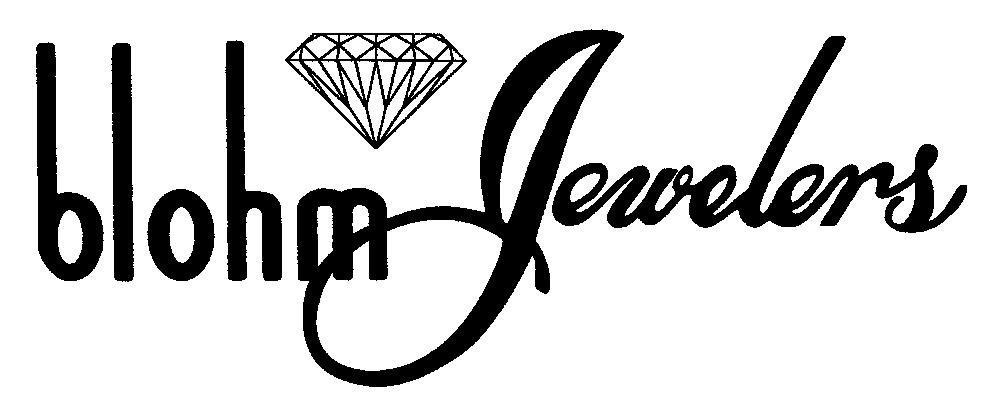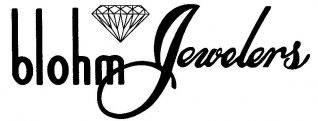
Are you looking for the perfect diamond?
Cut: The better the cut, the more brilliant

How do diamonds travel to the surface of the Earth?
The diamonds that we see at the surface are ones then that are brought to the surface by a very deep-seated volcanic eruption. It’s a very special kind of eruption, thought to be quite violent, that occurred a long time ago in the Earth’s history. We haven’t seen such eruptions in recent times. They were probably at a time when the earth was hotter, and that’s probably why those eruptions were more deeply rooted. These eruptions then carried the already-formed diamonds from the upper mantle to the surface of the Earth. When the eruption reached the surface it built up a mound of volcanic material that eventually cooled, and the diamonds are contained within that. These are the so-called Kimberlites that are typically the sources of many of the world’s mined diamonds.
How long does it take diamonds to form?
We really don’t know how long it takes. There have been attempts to try to date inclusions in different parts of diamonds, and those have largely been unsuccessful. It may be that diamonds form over periods as short a time as days, weeks, months to millions of years. Typically, as with many crystals that grow on the Earth, it’s not a continuous process. The diamonds may start to grow and then there may be an interruption for some reason – a change in conditions, temperature, pressure, source of carbon, whatever—and they could sit for millions, hundreds of million of years, and then start growing again. That’s part of the problem of trying to put some sort of a growth period on them; things don’t always occur continuously in the Earth.


How old then are diamonds?
All diamonds, as far as we know, are quite old in the Earth. Most diamond formation probably took place in the Earth in the first couple billion years of the Earth’s history. There are diamond deposits that have been discovered that are younger—the rock itself, the Kimberlite, is maybe just tens of hundreds of millions of years old. The way they date diamonds is typically looking at inclusions of other minerals in the diamond that can be radioactively dated. The diamonds themselves can’t be dated. But if the mineral inclusions contain certain elements like potassium and things that can be used in a radioactive dating scheme, then by dating the inclusion in the diamond you get some sense of the age of the diamond itself. And those dates always suggest the diamonds are quite old. At least hundreds of millions of years old, but in most cases billions of years old, anywhere from one to three billion years old, a time when the earth was probably hotter than it is today and so conditions were perhaps more appropriate for diamond growth.
Why does the Blohm family travel to Antwerp for the best diamond buying?
There’s a certain romance about giving your Valentine or yourself a stone from Antwerp, the oldest diamond centre in Europe. Records of stone trading in Antwerp date back to around 1450. Many diamonds filtered from India into Antwerp where skilled Flemish cutters fashioned them into gems. The discovery of diamonds in South Africa in 1869 helped the city’s diamond trade flourish and led to the first diamond trading organisations. Today, Antwerp remains one of the world’s largest diamond trading centres.
The heart of Antwerp’s diamond industry lies adjacent to the city’s historic main train station – beautifully restored to its 1890s splendour. The city’s main diamond trading hall, or bourse, is located across the street at 62 Pelikaanstraat. The nearest tram station is conveniently called Diamant (diamond in Flemish). The winding streets behind Pelikaanstraat, Schupstraat and Hovenierstraat are where most of the city’s $15 billion diamond trade happens.
Not surprisingly, security is extremely tight and travellers cannot visit most of the diamond trading halls or offices. But the nearby Museum aan de Stroom has a diamond pavilion to acquaint visitors with the process of diamond cutting and Antwerp’s diamond history.
However, what interest most travellers to Antwerp are the diamonds that have been cut and mounted onto jewelry.
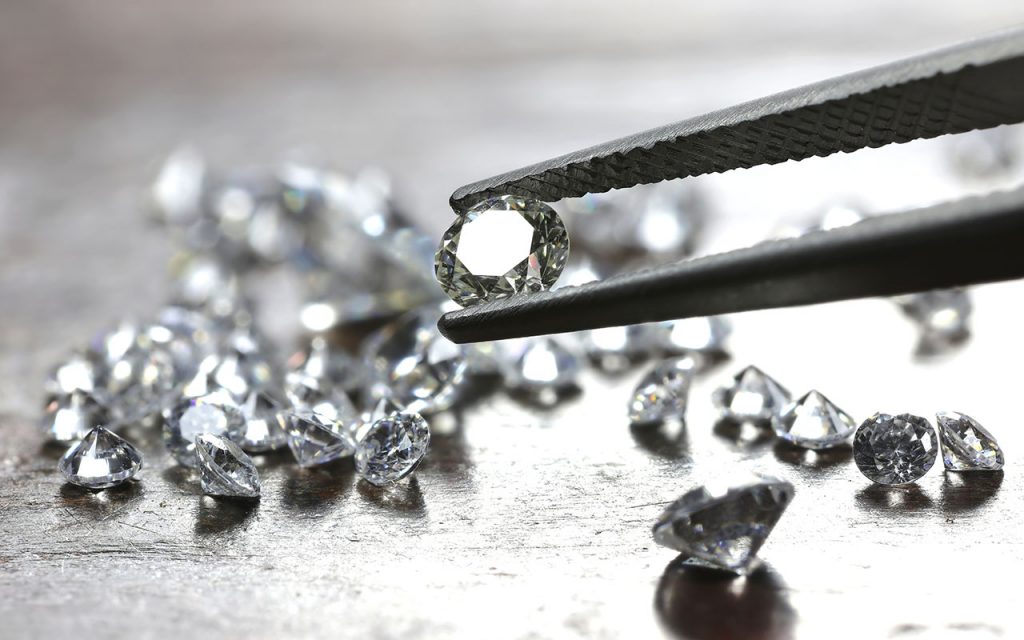

Origin of the Diamond 4Cs
Every diamond is a miracle of time and place and chance. Like snowflakes, no two are exactly alike.
Until the middle of the twentieth century, there was no agreed-upon standard by which diamonds could be judged. GIA created the first, and now globally accepted standard for describing diamonds: Color, Clarity, Cut, and Carat Weight. Today, the 4Cs of Diamond Quality is the universal method for assessing the quality of any diamond, anywhere in the world.
The creation of the Diamond 4Cs meant two very important things: diamond quality could be communicated in a universal language, and diamond customers could now know exactly what they were about to purchase.
COLOR
Diamond Color Actually Means Lack of Color
The diamond color evaluation of most gem-quality diamonds is based on the absence of color. A chemically pure and structurally perfect diamond has no hue, like a drop of pure water, and consequently, a higher value. GIA’s D-to-Z diamond color-grading system measures the degree of colorlessness by comparing a stone under controlled lighting and precise viewing conditions to masterstones, stones of established color value.
GIA’s diamond D-to-Z color-grading scale is the industry’s most widely accepted grading system. The scale begins with the letter D, representing colorless, and continues, with increasing presence of color, to the letter Z.
Many of these color distinctions are so subtle that they are invisible to the untrained eye; however, these distinctions make a very big difference in diamond quality and price.
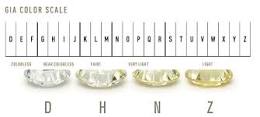

CLARITY
Diamond Clarity Refers to the Absence of Inclusions and Blemishes
Natural diamonds are the result of carbon exposed to tremendous heat and pressure deep in the earth. This process can result in a variety of internal characteristics called ‘inclusions‘ and external characteristics called ‘blemishes‘.
Evaluating diamond clarity involves determining the number, size, relief, nature, and position of these characteristics, as well as how these affect the overall appearance of the stone. While no diamond is perfectly pure, the closer it comes, the higher its value.
The GIA Diamond Clarity Scale has 6 categories, some of which are divided, for a total of 11 specific grades.
-
Flawless (FL)
-
No inclusions and no blemishes visible under 10x magnification
-
Internally Flawless (IF)
-
No inclusions visible under 10x magnification
-
Very, Very Slightly Included (VVS1 and VVS2)
-
Inclusions so slight they are difficult for a skilled grader to see under 10x magnification
-
Very Slightly Included (VS1 and VS2)
-
Inclusions are observed with effort under 10x magnification, but can be characterized as minor
-
Slightly Included (SI1 and SI2)
-
Inclusions are noticeable under 10x magnification
-
Included (I1, I2, and I3)
-
Inclusions are obvious under 10x magnification which may affect transparency and brilliance
Many inclusions and blemishes are too tiny to be seen by anyone other than a trained diamond grader. To the naked eye, a VS1 and an SI2 diamond may look exactly the same, but these diamonds are quite different in terms of overall quality. This is why expert and accurate assessment of diamond clarity is extremely important.
CUT
A Diamond’s Cut Unleashes Its Light
Diamonds are renowned for their ability to transmit light and sparkle so intensely. We often think of a diamond’s cut as shape (round, emerald, pear), but a diamond’s cut grade is really about how well a diamond’s facets interact with light.
Precise artistry and workmanship are required to fashion a stone so its proportions, symmetry, and polish deliver the magnificent return of light only possible in a diamond.
A diamond’s cut is crucial to the stone’s final beauty and value. And of all the diamond 4Cs, it is the most complex and technically difficult to analyze.
To determine the cut grade of the standard round brilliant diamond – the shape that dominates the majority of diamond jewelry – GIA calculates the proportions of those facets that influence the diamond’s face-up appearance. These proportions allow GIA to evaluate how successfully a diamond interacts with light to create desirable visual effects such as:
-
Brightness: Internal and external white light reflected from a diamond
-
Fire: The scattering of white light into all the colors of the rainbow
-
Scintillation: The amount of sparkle a diamond produces, and the pattern of light and dark areas caused by reflections within the diamond
GIA’s diamond cut grade also takes into account the design and craftsmanship of the diamond, including its weight relative to its diameter, its girdle thickness (which affects its durability), the symmetry of its facet arrangement, and the quality of polish on those facets.
The GIA Diamond Cut Scale for standard round brilliant diamonds in the D-to-Z diamond color range contains 5 grades ranging from Excellent to Poor.


CARAT WEIGHT
Diamond carat weight is the measurement of how much a diamond weighs. A metric “carat” is defined as 200 milligrams.
Each carat can be subdivided into 100 ‘points.’ This allows very precise measurements to the hundredth decimal place. A jeweler may describe the weight of a diamond below one carat by its ‘points’ alone. For instance, the jeweler may refer to a diamond that weighs 0.25 carats as a ‘twenty-five pointer.’ Diamond weights greater than one carat are expressed in carats and decimals. A 1.08 carat stone would be described as ‘one point oh eight carats.’
All else being equal, diamond price increases with diamond carat weight, because larger diamonds are more rare and more desirable. But two diamonds of equal carat weight can have very different values (and prices) depending on three other factors of the diamond 4Cs: Clarity, Color, and Cut.
It’s important to remember that a diamond’s value is determined using all of the 4Cs, not just carat weight.
DIAMOND SHAPES
The shape refers to the appearance of the stone, and the cut to the diamond’s ability to reflect light. Most diamond shapes are round, square (cushion), rectangular (princess, Asscher, emerald, radiant), heart-shaped, pear-shaped, oval, or marquise (like a pear but pointed on both ends).

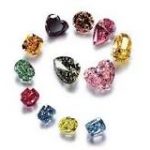
What is the rarest diamond color in the world?
Here are the rarest diamonds in the world.
-
Red Diamonds. These are the rarest diamonds in the world. …
-
Blue Diamonds. Blue is the second rarest fancy color. …
-
Pink Diamonds. Pink diamonds have a very high demand which can only be compared to Yellow Fancy Diamonds. …
-
Orange Diamonds. …
-
Green Diamonds.
